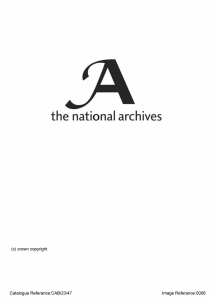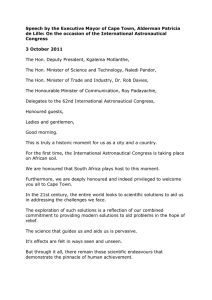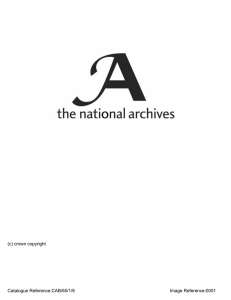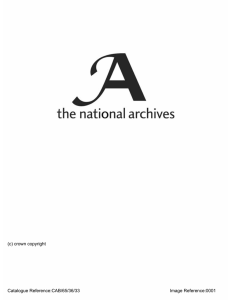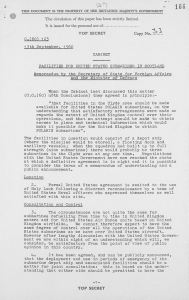(c) crown copyright Catalogue Reference:CAB/128/34 Image Reference:0035
advertisement
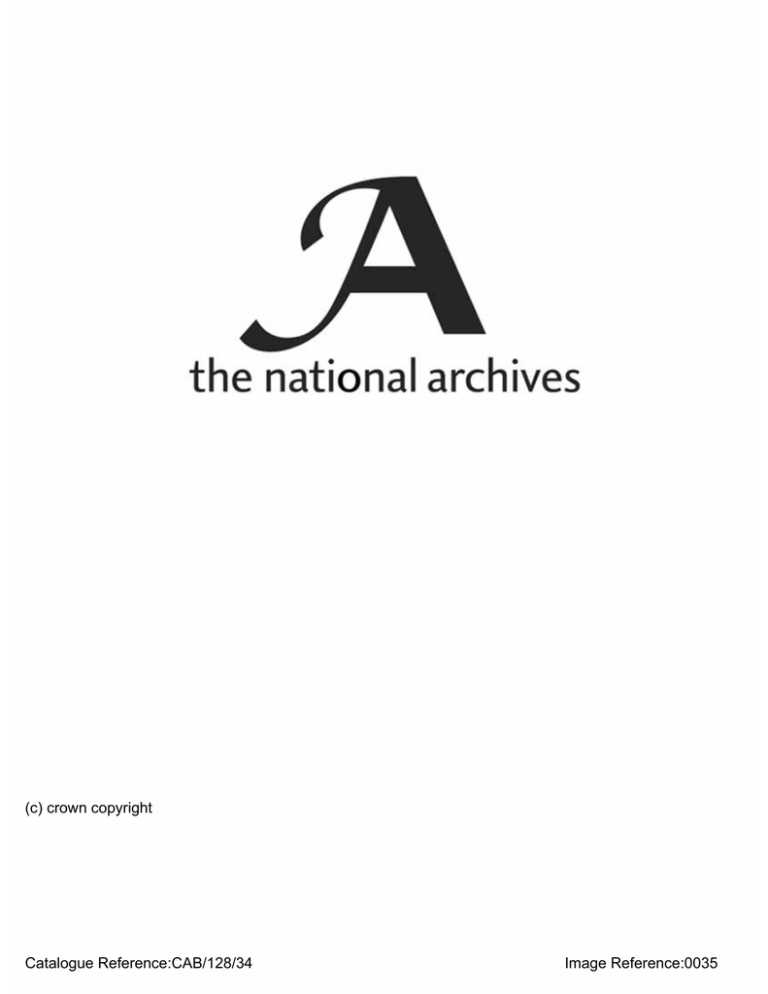
(c) crown copyright Catalogue Reference:CAB/128/34 Image Reference:0035 Printed for the Cabinet. June I960 C.C. (60) 35th Conclusions Copy No. 4 7 CABINET CONCLUSIONS of a Meeting of the Cabinet held in the Prime Ministers Room, House of Commons, S.W. 1, on Monday, 20th June, I960, at 5-30 p.m. Present: The Right Hon. HAROLD M.P., Prime Minister The Right Hon. S E L W Y N L L O Y D , Q.C., M . P . , Secretary of State for Foreign Affairs The Right Hon. The E A R L O F H O M E , Lord President of the Council and Secretary of State for Commonwealth Relations The Right Hon. D U N C A N S A N D Y S , M.P., Minister of Aviation The Right Hon. H E N R Y B R O O K E , M . P . , Minister of Housing and Local Government and Minister for Welsh Affairs The Right Hon. LORD MILLS, Paymaster-General The Right Hon. E R N E S T M A R P L E S , M . P . , Minister of Transport MACMILLAN, The Right Hon. R. A. B U T L E R , M . P . , Secretary of State for the Home Department The Right Hon. D. H E A T H C O A T A M O R Y , M . P . , Chancellor of the Exchequer The Right Hon. J O H N M A C L A Y , M . P . , Secretary of State for Scotland The Right Hon. H A R O L D W A T K I N S O N , M.P., Minister of Defence The Right Hon. Sir D A V I D E C C L E S , M.P., Minister of Education The Right Hon. J O H N H A R E , M.P., Minister of Agriculture, Fisheries and Food The following were also present: The Right Hon. L O R D C A R R I N G T O N , The Right Hon. G E O R G E W A R D , M . P . , First Lord of the Admiralty Secretary of State for Air The Right Hon. M A R T I N R E D M A Y N E , M.P., Parliamentary Secretary, Treasury Secretariat : CONTENTS Nuclear Weapo SKYBOLT POLARIS Nuclear Weapons The Cabinet had before them a note by the Minister of Defence (C. (60) 97) on the SKYBOLT missile. (Previous Reference: The Minister of Defence said that, following the agreement in C C . (60) 26th principle which the Prime Minister had reached with President Conclusions, Eisenhower in March, he had during his recent visit to Washington Minute 1) concluded a memorandum of understanding with the United States SKYBOLT Secretary of Defence about SKYBOLT to give effect to our intention to order this weapon if it were successfully developed in a form suitable for the Mark 2 V-Bombers of Bomber Command. He now sought approval for the negotiation of a more detailed technical and financial agreement with the United States authorities. There could as yet be no absolute certainty that SKYBOLT, which was hot due to be tested as a complete weapon for about a year, would be successful and it must be recognised that the Americans would not develop it for our use alone. However, the United States authorities were confident that it would be effective and they attached importance to it both for their own Air Force and as a means of prolonging the effectiveness of our V-Bombers, which they recognised were an important part of the strategic nuclear deterrent. By acquiring 144 missiles, with spares and associated equipment, we should be able in the later 1960s to maintain with the Vulcan Mark 2 bombers a deterrent force equivalent to that previously planned for BLUE STREAK. The Victor Mark 2 bombers would not be adapted for SKYBOLT, but could be a complementary component of the deterrent with a developed version of the British powered-bomb B L U E STEEL, if necessary. It would be in our interests to respond without delay to the American desire to expedite the joint development of SKYBOLT, in order to ensure that it would be fully compatible with our requirements. On present estimates, the cost of our requirement would be between £76 millions and £115 millions (depending on the unit cost of the missile), with a dollar content of up to £108 millions. We should have to ensure that the price would be based on the cost of production, without any contribution from us to the underlying development costs. We should only be committed to purchase if the price were on this basis and if the weapon was successful. The Chancellor of the Exchequer said that, while he felt there was a danger that the bomber force itself might have become unduly vulnerable by the time SKYBOLT was available, he recognised that, if the weapon were successful, the proposals of the Minister of Defence might be the cheapest means of maintaining an effective contribution to the Western deterrent. It was not possible to foresee at this stage the burden that the dollar costs would ultimately involve, but if this proved excessive our policy might have to be reconsidered at a later stage. Discussion showed that the Cabinet were in agreement with the course recommended by the Minister of Defence. They were informed that there was a promising prospect that the Vulcan Mark 2 aircraft would give longer service than originally planned; and that no need was foreseen at the present time to order additional replacement aircraft of this or another type, such as the VC-10, that would add to the cost of the programme. The Cabinet— (1) Approved the proposals in C. (60) 97. (2) Invited the Foreign Secretary, in consultation with the other Ministers concerned, to arrange for instructions to be sent to Her Majesty's Ambassador in Washington for the conclusion of a technical and financial agreement with the United States Government on SKYBOLT. *The Cabinet had before them a memorandum by the Minister of Defence (C. (60) 98) on POLARIS. The Minister of Defence recalled that the United States Government had welcomed the assurance which had been given by the Prime Minister in the course of his meeting with President Eisenhower in March that the United Kingdom Government would be agreeable in principle to making the necessary arrangements for a United States tender and a dock for POLARIS submarines to be stationed in Scottish waters. This project had been pursued in the recent discussions which he had held in Washington with Mr. Gates, the United States Secretary of Defence, who had asked that a formal agreement should be reached in time to enable the United States Navy to send a dry dock to Scottish waters early in July and a submarine tender before the end of the year. POLARIS submarines would be virtually invulnerable, and the United States authorities regarded them as a very important part of the diversified deterrent force which they planned to build up. The operational characteristics of these submarines, which would cruise submerged for two or three months, would pose complex communications and other problems, and careful organisation would be required to ensure the efficiency and reliability of their crews. The United States Government would welcome our close association with the United States Navy in this development and they hoped that the United Kingdom Government would feel able to participate, if only on a limited scale, in their POLARIS submarine plans. The use of facilities in Scottish waters would enhance the effectiveness of the POLARIS force by about 30 per cent. It had been suggested that if we could not meet this request the United States authorities might seek facilities at Bremerhaven, but it was doubtful whether they would in fact regard this as a satisfactory alternative. He had explained to Mr. Gates that the project raised important political and defence considerations. In order to justify it to public opinion in this country it would have to be presented as a joint project. This could be achieved if the United States Government were to give us an option to purchase or build our own P O L A R I S submarines. These, if we decided at a later date to exercise the option, would share the facilities which the American submarines needed in Scottish waters. It would also be necessary to make it clear that the POLARIS submarines which we might obtain in this way would be under the ultimate control of the United Kingdom Government. In this connexion it would be necessary to consider carefully the relation of any United Kingdom POLARIS missiles to the Medium Range Ballistic Missile scheme under which the Americans envisaged that POLARIS would be deployed in Europe as part of the forces of the North Atlantic Alliance" (the N A T O M.R.B.M. project). Discussion showed that the Cabinet recognised the importance in principle of missile submarines to the Western retaliatory deterrent. As the closest partner of the United States in the Western Alliance, it would be desirable that the United Kingdom should be associated with this form of the diversified deterrent, which was well suited to our maritime traditions. It would be desirable that the Americans should accept a basis of partnership for the facilities they wished to obtain in Scotland and to agree that we had the right to obtain a force of this sort of our own. We might indicate to the United States Government that it would be in their own interest, as well as ours, for the measures which we hoped to agree with them to be of a nature least likely to provoke hostile criticism in the United Kingdom. With this object in mind it would be important to avoid describing the facilities as an American base in Scotland. It might be found that the facilities we were providing need not, at least initially, be represented as permanent. If it were practicable, a further possibility which would enhance the attractiveness of the project would be for the United States Government to pay for the construction of some of their own POLARIS submarine hulls in the United Kingdom. The Cabinet next considered the question of control of P O L A R I S submarines operating from Scottish waters. It was suggested that, while the United States Government might agree that we should have a veto on the firing of any missiles from submarines in our territorial waters (and possibly within some greater distance from the United Kingdom coast line), they could hardly be expected to agree that we should share in the control of all firings from their submarines operating from Scottish waters. In practice a satisfactory arrangement might be reached if the POLARIS "submarines were placed under the command of the Supreme Allied Commander Atlantic (SACLANT) in his capacity as an American officer, and if officers of the Royal Navy could be associated with the staffs responsible for the POLARIS project at S A C L A N T s Headquarters. This concept would, however, be different from that which the United States had proposed for the N A T O M.R.B.M. project, under which command would be exercised by the Supreme Allied Commander, Europe (SACEUR) and the United States would retain control of the POLARIS warheads assigned to the North Atlantic Alliance forces. It was not yet certain that the M.R.B.M. project would be accepted by N A T O ; it was open to objection, both politically and militarily, since it would for the first time place weapons of a strategic deterrent character under the command of S A C E U R and might lead to their deployment in Western Germany. In further discussion it was agreed that an option for the United Kingdom to acquire POLARIS submarines would not involve any commitment for their purchase or for their construction in this country. The total capital cost of three submarines for the United Kingdom might be of the order of about £150 millions over about nine years. It was suggested that our financial resources would not be sufficient to permit the United Kingdom to embark on a P O L A R I S as well as a SKYBOLT programme. The Cabinet then considered where the facilities required by the United States Navy could most suitably be found in Scotland. Gareloch was favoured by the United States authorities because of the accommodation and amenities available in the district and its proximity to Prestwick airport. But it was generally felt that public opinion would be critical of any proposal to provide facilities in the densely populated area of the Clyde and that a more isolated place would also be preferable on security grounds. Subject to further technical examination a suitable alternative might be found at Loch Linnhe, near Fort William. Summing up the discussion, the Prime Minister said that it would be of advantage to the West as a whole and to our partnership with the United States if satisfactory arrangements could be made for the United States Navy to have facilities for the operation of P O L A R I S submarines from Scottish waters. It should be possible to justify the P O L A R I S project to public opinion if it could be presented as a joint venture and if, through the option to acquire our own POLARIS submarines, we were seen to have the right of joining fully with the Americans in the operation of a submarine deterrent force if we so desired. In view of the importance of the issues involved, the Cabinet should consider the matter further on 23rd June. It was desirable that an urgent technical study should be made with a view to determining the suitability of Loch Linnhe and its acceptability, on safety grounds, to the Atomic Energy Authority. (3) Invited the Minister of Defence, in consultation with the other Ministers concerned, to submit to the Prime Minister for consideration at the Cabinet's meeting on 23rd June, the draft of a message to President Eisenhower on the question of facilities in Scotland for United States POLARIS submarines. (4) Invited the Frst Lord of the Admiralty, in consultation with the Secretary of State for Scotland, to prepare for consideration by the Cabinet on 23rd June a report on the suitability of Loch Linnhe for the facilities required for this purpose by the United States Navy. Cabinet Office, 21st June, S.W.1, 1960.
